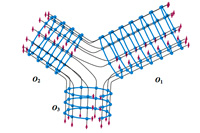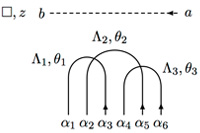Research Fields
Our current understanding of the basic constituents of matter and interactions among them is based on quantum field theory and gauge symmetries. All known forces in Nature are mediated by gauge fields. The gauge interactions are well under theoretical control in their weak coupling regime, where perturbative computations based on Feynman diagrams reach remarkable levels of precision. These include the weak and electromagnetic interactions, and strong interactions at asymptotically high energies. However, gauge theories such as quantum chromodynamics (QCD) are in general strongly coupled, and the full understanding of their dynamics requires non-perturbative methods.
Exactly solvable, or integrable, models play a distinguished role in physics, helping us to understand the behavior of strongly correlated, strongly coupled systems in regimes where other methods fail. They have many applications in quantum theory ranging from condensed-matter to high energy physics. For a long time, exact solvability was associated only with (1+1)-dimensional quantum field theories and statistical systems. Powerful methods of integrability provide tools to understand the dynamics of these systems even in the strongly-coupled, non-perturbative regime.
The application of similar techniques directly to four dimensional gauge theories has been a long-standing dream, which has begun to be realised in a quite unexpected manner. The major step in this direction was the discovery of the AdS/CFT (Anti-de Sitter / Conformal Field Theory) duality, which established a precise relationship between gauge fields and strings. It was then realized that the two-dimensional dynamics on the string worldsheet is in many cases integrable, paving the way for application of non-perturbative, integrability-based methods to four-dimensional gauge theories.
The best studied example of this sort concerns N = 4 super-Yang-Mills (SYM) theory in the limit of large numbers of colours (‘large-N’). Feynman diagrams that contribute in this limit have planar topology and it has long been expected that the large-N limit is described by some kind of string theory. The AdS/CFT correspondence is the first case in which the relationship to string theory has been made precise. Moreover, planar diagrams in N = 4 SYM can be summed exactly with the help of integrability. The spectrum of this theory is described by the Hamiltonian of an integrable spin chain, as was first established by explicit perturbative computations.
On the other side of the AdS/CFT duality, the string worldsheet is described by an integrable two-dimensional sigma-model. By using integrability it was possible to find a set of Bethe ansatz equations that diagonalize the exact S-matrix of elementary magnon excitations of the spin chain, or equivalently, the soliton spectrum of the sigma-model. The exact spectral equations for the system are of Thermodynamic Bethe Ansatz (TBA) type, and can be compactly represented as through a set of functional equations called the Y-system, describing non-perturbatively the common spectrum of N = 4 super-Yang-Mills theory and string theory on the AdS5 xS5 background.
These have recently been reduced to a finite set of non-linear integral equations of Destri – de Vega type. By combining state-of-the-art analytic methods with computer algebra and numerical analyses, it was possible to find quantities in N = 4 SYM that interpolate smoothly between perturbation theory at weak coupling and string theory at strong coupling. Examples include the cusp anomalous dimension, the static potential, the scaling dimension of the Konishi operator, and the expectation value of the circular Wilson loop. These are the first examples of this kind, where a non-perturbative computation is possible in an interacting four-dimensional quantum field theory. This leaves the question of how this connects to more familiar weak-coupling calculations in a gauge theory.
An unexpected and exciting bridge comes from recent remarkable progress in calculational techniques of gauge theory scattering amplitudes, especially in N = 4 SYM theory. Computing scattering amplitudes is an important but rather difficult problem with many applications in particle phenomenology. In N = 4 SYM unexpected and non-trivial links to (momentum) twistors, Wilson loops and integrable systems have been discovered using the AdS/CFT correspondence and integrability. The scattering amplitudes in N = 4 SYM possess unexpected hidden symmetries, such as dual conformal symmetry, and Yangian symmetry. These are instrumental in understanding the general structure of the amplitudes both in the weak-coupling perturbation theory as well as at strong coupling where the amplitudes can be efficiently computed with the help of TBA or Y-system equations.
Developments at weak and strong coupling all point towards a complete reinterpretation of N = 4 SYM in terms of an integrable system. This would constitute the first example of its kind in four dimensions and presents many exciting research opportunities. The recent progress in understanding non-perturbative and perturbative phenomena in gauge theories demonstrates the need to combine the techniques of integrability, conformal field theory and string theory. To be able to make the most of the opportunities presented in this field it is crucial that the new generation of physicists is trained in this wide variety of tools and techniques.
Some key problems in the field of gauge/string integrability which we believe will dominate the next phase of its development are: the spectral problem, correlation functions, and scattering amplitudes.



